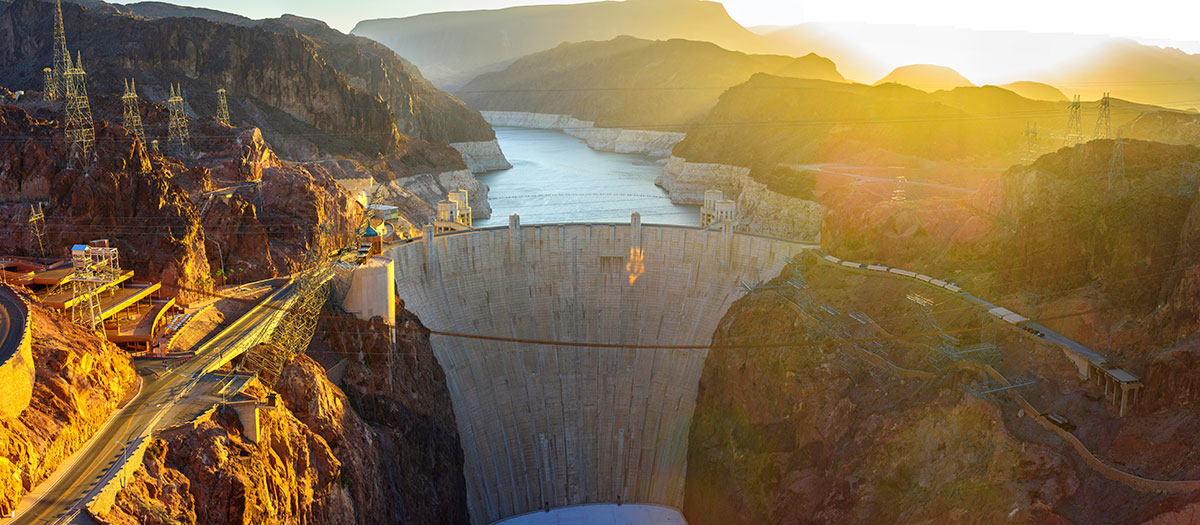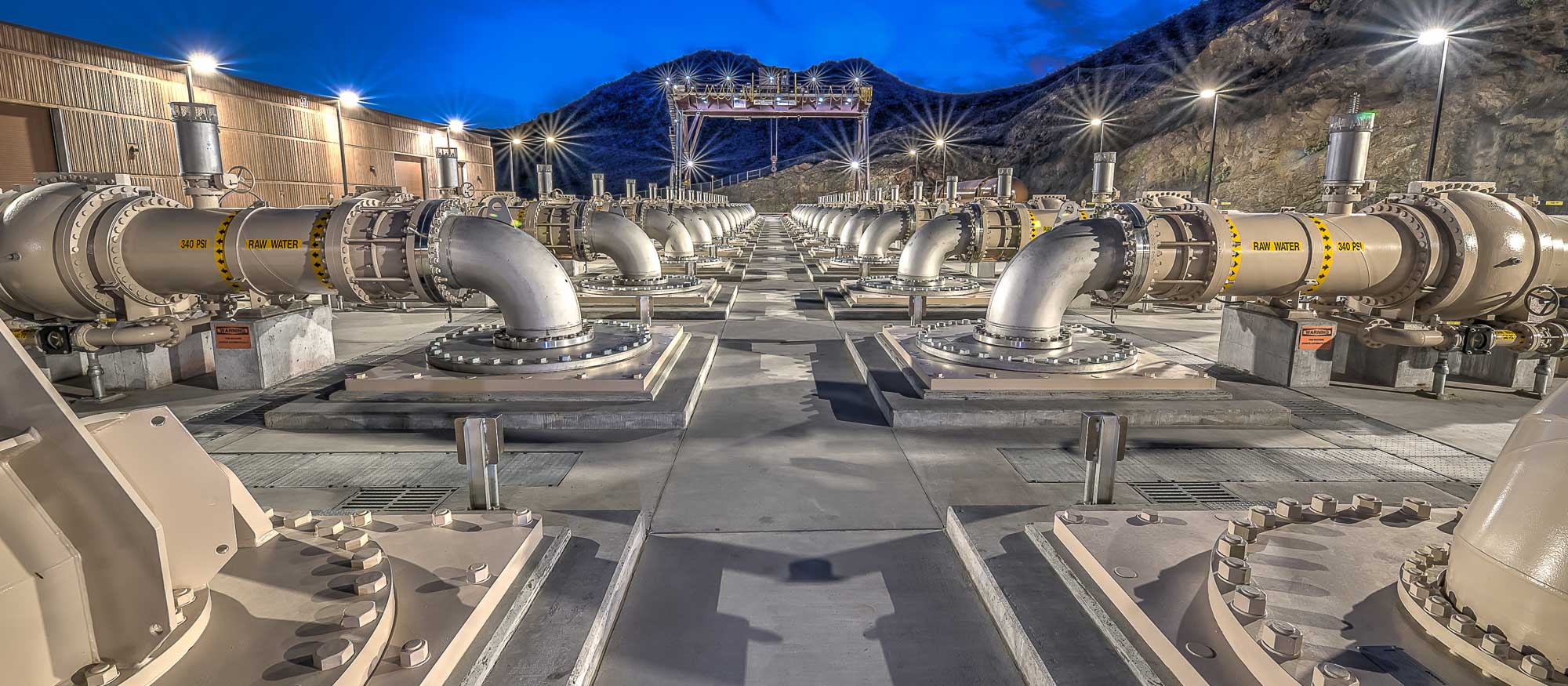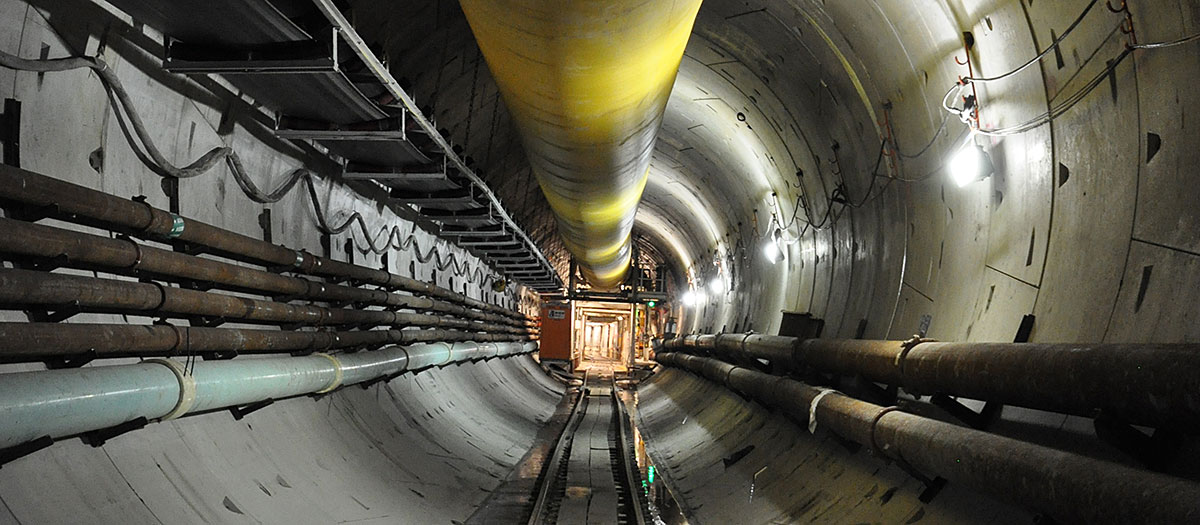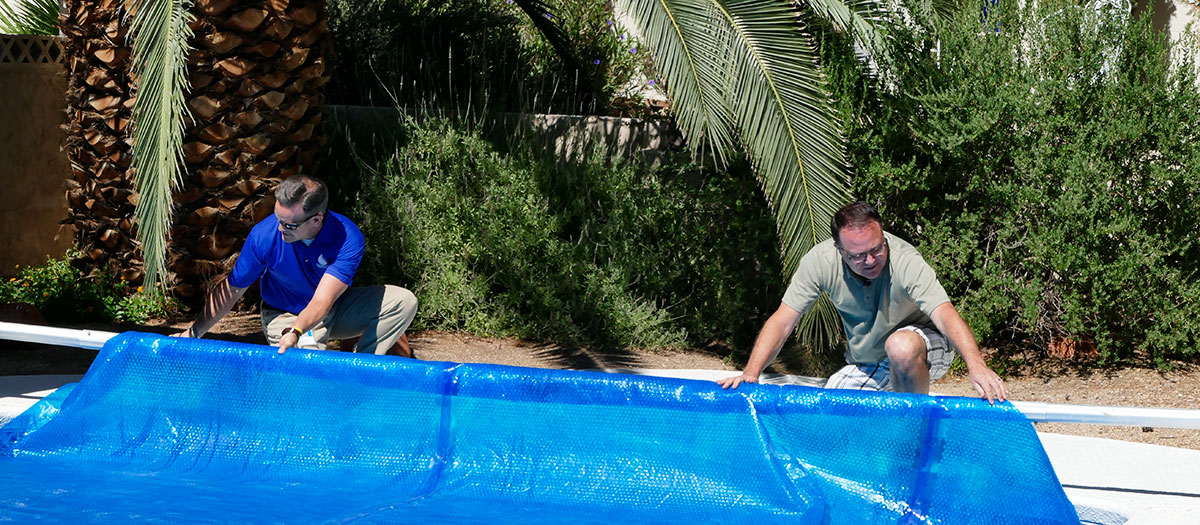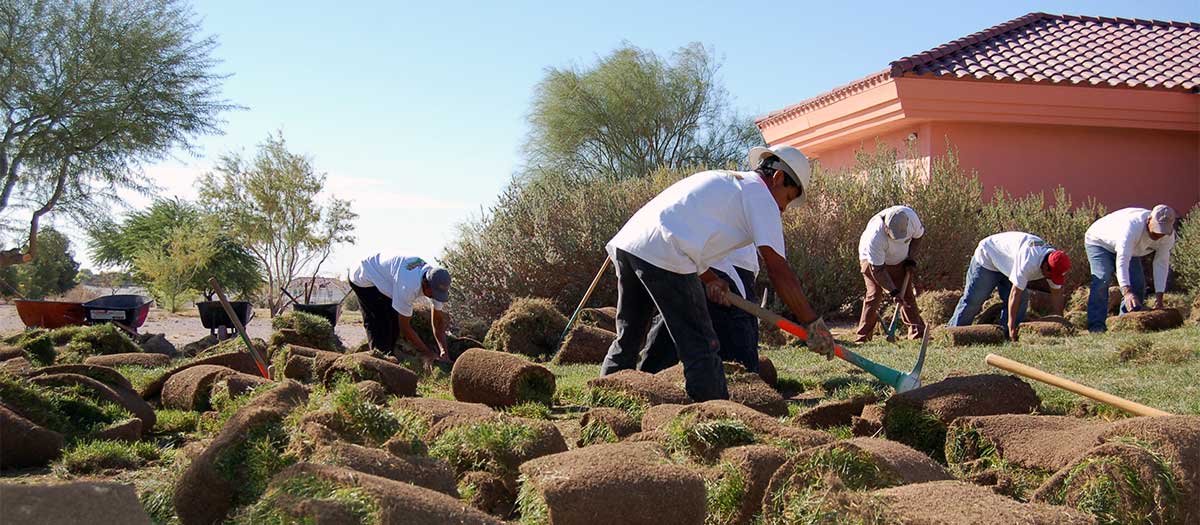In 1991, seven local water and wastewater agencies formed the Southern Nevada Water Authority (SNWA) to address water issues on a regional basis, rather than an individual water purveyor basis.
Collectively, SNWA member agencies serve more than 2 million residents in Southern Nevada. As the wholesale water provider, SNWA is responsible for water treatment and delivery, as well as acquiring and managing long-term water resources for Southern Nevada.
Our mission is to provide world-class water service in a sustainable, adaptive, and responsible manner to our customers through reliable, cost-effective systems.
Milestones
Low Lake Level Pumping Station operational (2022)
Completed in 2020, the Low Lake Level Pumping Station began operating in April 2022 when the dramatic drop in the elevation of Lake Mead rendered one of our community's primary intake pumping station inoperable. The pumping station ensures Southern Nevada maintains access to its primary water supplies at Lake Mead even if lake levels continue to decline due to drought.
Law bans useless grass (2021)
A law enacted by the Nevada Legislature in 2021 prohibits using Colorado River water delivered by Water Authority member agencies to irrigate nonfunctional grass.
The law requires the removal and/or replacement of this grass by the end of 2026 throughout Southern Nevada at commercial, multi-family, government and other properties. It does not apply to grass in homeowners' yards, or to grass used for recreation at schools and parks.
Low Lake Level Pumping Station completed (2020)
Completed in 2020, the Low Lake Level Pumping Station ensures Southern Nevada maintains access to its primary water supplies at Lake Mead even if lake levels continue to decline due to drought.
Drought contingency plans signed (2019)
Representatives from the seven Colorado River basin states formally signed drought contingency plans for the upper and lower basins. The plans are designed to reduce risks from ongoing drought and the impact of declining water levels in Lake Mead and Lake Powell. Under the Lower Basin Drought Contingency Plan, Nevada, Arizona and California would make a series of voluntary water contributions to keep water in Lake Mead. The amount of each state’s voluntary contribution is based on Lake Mead water elevation. These contributions are designed to slow Lake Mead's decline and reduce the potential of the lake dropping to critical operating elevations. The voluntary contributions are in addition to previously negotiated mandatory shortage reductions.
Alfred Merritt Smith Water Treatment Facility receives award (2019)
The Water Authority’s Alfred Merritt Smith Water Treatment Facility received the American Water Works Association's Partnership for Safe Water’s Excellence in Water Treatment award for adopting best practices in water treatment.
Partnership for Safe Water’s Excellence in Water Treatment award (2018)
The Water Authority’s River Mountains Water Treatment Facility received the Partnership for Safe Water’s Excellence in Water Treatment award, one of the water industry's highest honors.
Inaugurated into the Leading Utilities of the World (2018)
The Water Authority and the Las Vegas Water District are inaugurated into the Leading Utilities of the World, a global network of the world’s most innovative water utilities and agencies. Both organizations were recognized for innovation, advances and solutions to water challenges.
Water Smart Landscapes Rebate increased (2018)
To increase water conservation efforts, the Water Authority in May 2018 expanded its conservation program incentives - allowing Water Smart Landscapes Rebate program participants to receive up to $3 for every square foot of grass converted to water smart landscaping. Additionally, Water Efficient Technologies program rebate amounts were increased for commercial and multifamily business owners.
Warm Springs Natural Area opens to public (2017)
The Water Authority opened the Warm Springs Natural Area to the public, after the completion of a public access area that includes a 2/3-mile trail with informational kiosks and interpretive exhibits, benches, and viewing areas. Located approximately seven miles northwest of the town of Moapa, the property (formerly known as the Warm Springs Ranch) contains more than two dozen springs. The Water Authority acquired the Warm Springs Natural Area to protect the headwaters of the Muddy River and the habitat of the endangered Moapa dace.
WaterSmart Innovations Conference and Exposition marks 10th anniversary (2017)
For the tenth year in a row, the Southern Nevada Water Authority hosted the WaterSmart Innovations Conference and Exposition, the world's premier event for innovative water-efficiency technology and services. Since 2007, the conference has brought together thousands of water industry professionals from around the world to participate in the largest conference dedicated the urban water efficiency.
Agreement signed between U.S. and Mexico (2017)
In August 2017, Minute 323 was signed, defining Colorado River water deliveries to Mexico under high- and low-reservoir conditions and permitting storage of Mexico's deferred Colorado River water deliveries in Lake Mead. Under the terms of Minute 323, Mexico agrees to absorb a share of shortages should Lake Mead fall below specific elevations, slowing the lake's decline if the drought persists. Other key elements of Minute 323 include environmental restoration and a variety of water conservation projects to be undertaken within that nation.
Intake No. 3 begins conveying water (2015)
Built to address unprecedented drought conditions, the third drinking water intake began delivering water to Southern Nevadans in September 2015. Intake No. 3 can draw upon Colorado River water at elevations below 1,000 feet above sea level.
Water Smart Landscapes Rebate increased (2015)
In July 2015, the Water Authority increased its Water Smart Landscapes Rebate, allowing program participants to receive up to $2 for every square foot of grass converted to water smart landscaping. Since the program's inception in 1999, millions of square feet of turf have been removed, saving billions of gallons of water annually.
Low Lake Level Pumping Station approved (2015)
The Southern Nevada Water Authority's board of directors approved the construction agreement of a Low Lake Level Pumping Station at Lake Mead in May 2015. Once complete, the pumping station will ensure Southern Nevada maintains access to its primary water supply.
River Mountains Solar Facility completed (2015)
Furthering its commitment to sustainability, SNWA partnered with SunEdison which constructed a 14-megawatt River Mountains Solar Facility, to provide enough clean and renewable energy to power a portion of the River Mountains Water Treatment Facility.
Intake No. 3 tunnel bores through (2014)
Concluding a 3-mile journey that began in 2011, a tunnel boring machine excavating Southern Nevada’s third water intake beneath Lake Mead reached its destination in December 2014 when it holed through the concrete intake riser structure.
Advisory committee makes recommendations (2014)
In November 2014, the SNWA's Integrated Resource Planning Advisory Committee presented its recommendations to the SNWA Board. The stakeholder committee’s recommendations included a new Low Lake Level Pumping Station to secure access to water supplies during extreme drought conditions and a rate modification to fund the pumping station.
System Conservation Program initiated (2014)
In April 2014, the U.S. Bureau of Reclamation, Central Arizona Project, Denver Water, the Metropolitan Water District of Southern California and Southern Nevada Water Authority committed to fund pilot Colorado River water conservation projects, which will benefit the Colorado River system by conserving additional water in Lake Powell and Lake Mead.
John Entsminger named General Manager (2014)
John Entsminger was approved as SNWA's new General Manager in January 2014. Formerly the agency's principal lead for Colorado River negotiations, John succeeded Patricia Mulroy, who served as general manager for more than 20 years.
BLM issues rights-of-way (2013)
In May 2013, the Bureau of Land Management issued rights-of-way for the primary water and power conveyance facilities of the SNWA's Groundwater Development Project.
Integrated Resource Planning Advisory Committee (2012-2015)
In 2012, a 21-member committee was formed to guide future water resource planning for Southern Nevada. The advisory committee process included two phases: the first addressed debt service and critical water infrastructure needs, and the second evaluated the risk of declining lake levels. The committee made recommendations that included phased rate increases to fund infrastructure and a new Low Lake Level Pumping Station to ensure Southern Nevada’s access to its primary water supplies in Lake Mead.
Water pact signed with Mexico (2012)
In November 2012, SNWA and several U.S. federal and state agencies signed a series of agreements to implement Minute 319 to the 1944 Mexican Water Treaty. Minute 319 creates a new binational framework to address shortages and surpluses on the Colorado River, and allows Mexico to store water in Lake Mead for future use. The five-year pilot project is instrumental in funding improvements to Mexico’s water infrastructure and conservation measures. The agreement helps ensure the Colorado River system can meet the needs of both countries.
State Engineer rules on Spring, Cave, Dry Lake, and Delamar Valleys (2012)
In 2012, the Nevada Office of the State Engineer granted the Water Authority rights to 83,988 acre-feet of water in Spring, Cave, Dry Lake and Delamar valleys. The total amount of water permitted is dependent on staged pumping, biological and hydrological data collection, groundwater flow models and monitoring, mitigation and management programs. SNWA also holds groundwater rights to more than 8,000 acre-feet per year in Spring Valley through its Great Basin Ranch holdings.
Colorado River Basin Supply and Demand Study (2011)
The U.S. Bureau of Reclamation and the Colorado River Basin states initiated the Colorado River Basin Supply and Demand Study to define current and future water supply and demand imbalances in the basin and assess the risks to basin resources. The study concluded in December 2012.
Water Smart Landscapes program receives grant to expand (2010)
The Water Smart Landscapes program received a $1 million grant from the U.S. Bureau of Reclamation in order to provide financial incentives for approximately 777,000 additional square feet of turf conversions.
Capital Improvements Plan retired (2010)
In February 2010, the Southern Nevada Water Authority Board approved retirement of the Capital Improvements Plan 14 years after it was first issued and achieved the goals for which it was established. The plan's remaining projects, including Intake No. 3, were consolidated into an amended Major Construction and Capital Plan (MCCP).
Yuma Desalting Plant pilot run (2010)
The Southern Nevada Water Authority entered into an agreement with municipal water agencies in Arizona and California, the U.S. Bureau of Reclamation and the Colorado River Commission to fund the Yuma Desalting Plant Pilot Run. A pilot run of the plant, conducted in 2010/2011, provided information about the readiness of the plant and enabled the development of recommendations for future operations to help augment Colorado River flows.
Photovoltaic systems (2009)
The Water Authority incorporated photovoltaic technologies into its water system operations, including solar panels that provide covered parking at both of our treatment facilities, and a unique high-concentrated system that produces clean energy.
Mandatory drought restrictions made permanent (2009)
Due to extended drought conditions in Southern Nevada, the Water Authority’s member agencies elected to make drought restrictions permanent in an effort to help meet long-term resource needs. Among mandatory drought restrictions are turf limitations, landscape watering and vehicle washing guidelines.
First annual WaterSmart Conference and Exposition (2008)
In partnership with the U.S. Environmental Protection Agency's WaterSense program, the Water Authority held the first annual WaterSmart Innovations Conference and Exposition, sharing information about effective conservation programs and policies and introducing new water-efficient technologies.
Water Utility Climate Alliance (2008)
The Southern Nevada Water Authority joined with seven of the nation's largest water agencies to form the Water Utility Climate Alliance. The alliance provides leadership in assessing and adapting to the potential effects of climate change through collaborative action.
Construction begins on Intake No. 3 (2008)
The Water Authority began construction on a third intake to protect municipal water customers from water quality issues associated with declining lake levels and to maintain our ability to draw upon Colorado River water even at extremely low Lake Mead elevations.
Water Quality Laboratory and Applied Research & Development Center (2007)
In 2007, the Southern Nevada Water Authority completed the Water Quality Laboratory and Applied Research & Development Center which houses one of the most sophisticated municipal water quality laboratory complexes in the world. Using the lab, staff optimizes existing treatment techniques and researches new water treatment technologies.
Warm Springs Natural Area (2007)
The Water Authority purchased the Warm Springs Natural Area to protect the headwaters of the Muddy River and the habitat of the endangered Moapa dace. Located approximately seven miles northwest of the town of Moapa, the property (formerly known as the Warm Springs Ranch) contains more than two dozen springs.
Colorado River augmentation study (2007)
With the Colorado River in a severe drought and decreasing water levels at both Lake Mead and Lake Powell, the seven Colorado River Basin States in 2007 conducted an analysis of potential measures that could be used to augment the water supply provided by the river.
Intentionally created surplus (2007)
The U.S. Secretary of the Interior signed the Record of Decision on the Colorado River Interim Guidelines for Lower Basin Shortages and Coordinated Operations for Lake Powell and Lake Mead. The guidelines provide for Intentionally Created Surplus on the Colorado River, which has allowed Nevada to increase its supplies by including tributary water from the Muddy and Virgin Rivers, Warren H. Brock Reservoir in California, and Coyote Spring Valley.
Warren H. Brock Reservoir (2007)
The Warren H. Brock Reservoir was constructed to capture U.S. Colorado River water that would otherwise go unused in the Lower Basin and pass into Mexico. This System Efficiency ICS project provides Southern Nevada 400,000 acre-feet of ICS credits.
Water Smart Landscapes rebate increase (2007)
In 2007, the Water Authority increased its Water Smart Landscapes rebate, encouraging residential and commercial property owners to remove grass and replace it with water-efficient landscaping. Since the program's inception in 1999, millions of square feet of turf have been removed, saving billions of gallons of water annually.
Pool Cover Rebate Coupon program (2005)
To increase community awareness about the water-saving benefits of pool covers, a rebate prorgam was established, ultimately saving an estimated 5.6 billion gallons of water between 2005 and 2020.
Water Smart Home program (2005)
Joining with local home builders, the Water Authority introduced the Water Smart Home program to help create communities of water-efficient homes. As water-efficient technologies have become the standard in new homes, the need for the Water Smart Homes program became less necessary and was discontinued in 2020.
Silverhawk Power Plant begins operation (2004)
In May 2004, this 570-megawatt electric power generation facility in Apex, Nevada, began operations, providing a reliable power source for the Water Authority’s water treatment facilities and pumping stations. Between 2004 and 2017, the authority (the largest consumer of power in the Las Vegas Valley) owned 25 percent of the facility. In 2017, the Authority transferred its interest in the plant to NVEnergy.
California Water Bank (2004)
The Water Authority and the Colorado River Commission entered into agreements with the Metropolitan Water District of Southern California and the Bureau of Reclamation to store unused Colorado River water in California until it is needed.
Integrated Water Planning Advisory Committee (2004)
The drought required the Southern Nevada Water Authority to accelerate development of groundwater rights, surface water rights and groundwater applications in Clark, Lincoln and White Pine counties. To help facilitate this, the Water Authority launched an integrated water planning process, which included the formation of an Integrated Water Planning Advisory Committee (IWPAC). The IWPAC assessed alternatives and developed general recommendations for the SNWA Board of Directors.
Ozonation (2003)
Ozonation became the primary method of water treatment for Southern Nevada when the ozonation process went online at the valley's water treatment facilities in 2003. Ozonation destroys bacteria and other microorganisms through an infusion of ozone, a gas produced by subjecting oxygen molecules to high electrical voltages.
Drought Plan (2003)
The Drought Plan was first developed in 2002 and adopted by the Southern Nevada Water Authority Board of Directors in February 2003. The plan outlines the SNWA approach to meeting customer demands during shortage conditions. In 2009, the plan was incorporated as a new chapter in the SNWA Water Resource Plan.
River Mountains Water Treatment Facility opens (2002)
The River Mountains Water Treatment Facility opened in October 2002. It has a capacity to treat and deliver up to 300 million gallons of water per day and can be expanded to treat up to 600 million gallons of water per day.
Interim surplus criteria agreement (2001)
The Secretary of the Interior signed an agreement making additional surplus Colorado River water available to Nevada until the year 2016. This agreement also required California to reduce its water use from more than 5 million acre feet each year to its allotted 4.4 million acre feet.
Arizona banking agreement (2001)
This agreement helps secure Nevada's future water supply by allowing the state to divert unused and surplus water from the Colorado River and store it underground in Arizona for future use.
Water Smart Landscapes rebate (1999)
In 1999, the Water Authority implemented its Water Smart Landscapes rebate to encourage residential and commercial property owners to remove grass and replace it with water-efficient landscaping. Since the program began, millions of square feet of grass have been removed saving billions of gallons of water each year.
Las Vegas Wash restoration efforts begin (1998)
The Water Authority, along with other local agencies, launched restoration efforts in 1998 as part of the Las Vegas Wash Coordination Committee's management plan to restore this fragile area. The project addresses environmental concerns by decreasing erosion and by increasing wetlands that improves water quality and support a vast array of wildlife.
Las Vegas Wash Coordination Committee (1998-present)
Formed as part of a recommendation by the Water Quality Citizens Advisory Committee, the Las Vegas Wash Coordination Committee includes stakeholders throughout the community to address the many issues related to the Las Vegas Wash. Since its establishment, committee recommendations have been formalized into the Las Vegas Wash Comprehensive Adaptive Management Program.
Water Quality Citizens Advisory Committee (1997-98)
Increasing concerns about wastewater discharges in the Las Vegas Wash led to the establishment of a committee to evaluate the best approach to stabilizing erosion issues in the Las Vegas Wash. Committee recommendations from this process led to a more comprehensive management program for the watershed.
Advisory Committee for Groundwater Management (1997-present)
To protect and manage the Las Vegas Valley's primary groundwater supply, the Nevada Legislature directed the SNWA to establish an advisory committee to evaluate current groundwater conditions and make recommendations to further protect and enhance the basin. Their recommendations have yielded a permanent artificial recharge program, a well-conversion grant program and conservation incentives for well users.
Las Vegas Valley Groundwater Management Program (1997)
The Water Authority developed the groundwater management program in 1997 to protect and manage the Las Vegas Valley's primary groundwater supply.
Capital Improvements Program (1995)
The Southern Nevada Water Authority launched a public works program in 1995 to ensure that water delivery keeps pace with unprecedented growth in the Las Vegas Valley. In 1998, 72 percent of Southern Nevada voters overwhelmingly approved a quarter-penny sales tax increase to help fund the improvements.
Colorado River Commission Partnership (1995)
The Water Authority partnered with the Colorado River Commission to identify water resources, provide an efficient, reliable water supply, and build and maintain new power facilities.
Integrated Resource Planning Advisory Committee (1994-1998)
To develop recommendations on future water resources and funding for new regional facilities, the SNWA formed the Integrated Resource Planning Advisory Committee in 1994. The 21-member committee made nearly two dozen recommendations, including the implementation of ozonation at water treatment facilities and increased conservation efforts.
Lower Colorado River Multi-Species Conservation Program (1994)
Nevada, Arizona, and California signed an agreement with the U.S. Department of the Interior to develop a plan to protect three species of endangered fish. The move helps conserve and improve habitat for the species.
Bureau of Reclamation contract (1992)
The Water Authority signed a contract with the Bureau of Reclamation allowing Nevada to draw its full allotment of 300,000 acre-feet and surplus flows from the Colorado River.
Water conservation program (1991)
When the Water Authority was formed, it made water conservation a critical component of its long-term water resource plan. SNWA has one of the most aggressive and comprehensive water conservation programs in the nation, helping the community save billions of gallons of water each year.
SNWA established (1991)
Local agencies formed the Southern Nevada Water Authority in 1991 to address Southern Nevada's unique water needs on a regional basis. The Water Authority is committed to managing the region's water resources and developing solutions that will ensure adequate future water supplies for the Las Vegas Valley.
